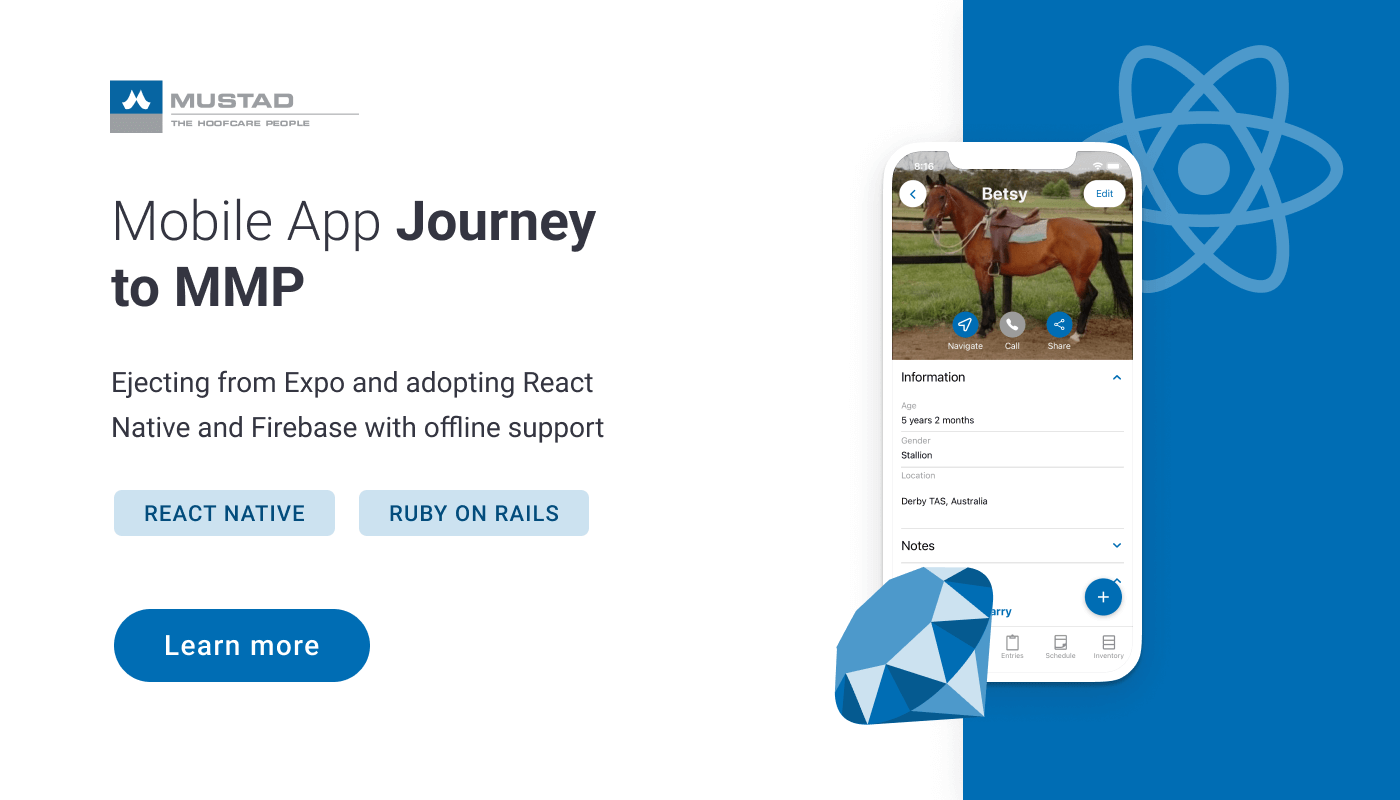The State of Vue.js Report 2025 is now available! Case studies, key trends and community insights.
Table of Contents
Do you want to build a sleek mobile app quickly and efficiently? Then you've probably heard about two leading frameworks - Flutter and React Native. Both platforms offer powerful solutions, but the real question is, Flutter vs. React Native—Which should you choose? What's the difference between them? Which one is better for building an MVP (Minimum Viable Product)?
In this post, I will cover these questions (and more) to give you a better understanding of how your business can benefit from Flutter and React Native development and when to choose which framework.
Is Cross-Platform App Development the Future?
In recent years, the importance of mobile devices has continued to grow, and today, highlighting the significance of a mobile-first approach would be somewhat redundant. Datareportal statistics show fewer than 6 in 10 working-age internet users report owning a laptop or desktop computer.
However, using shared devices and employer-provided computers means that just under two-thirds of internet users still use some type of computer to go online.
As a result of this decline in computer ownership, Datareportal predicts that the balance of device usage time will continue shifting towards mobile.

Device ownership worldwide - January 2023 (Source: DataReportal)
According to recent Datareportal statistics, mobile devices dominate internet usage, with fewer than six out of ten internet users owning a traditional computer. This shift has pushed many companies to focus on mobile app development, particularly cross-platform frameworks like Flutter and React Native, which allow developers to create apps for multiple platforms using a single codebase.
This rising trend has made Flutter app development services and React Native development some of the most sought-after in the industry, as they offer speed, cost-efficiency, and the ability to reach a larger audience.
Read more about cross-platform development: Cross-Platform App Development 101: What Is It and How Does It Work?
What is Flutter?
Flutter, developed by Google, is a robust cross-platform development framework that allows you to build beautiful, natively compiled applications for mobile, web, and desktop from a single codebase.
As a leading Flutter app development company, we often recommend Flutter for its rich set of customizable widgets, which enables the creation of stunning user interfaces. Whether you’re building for Android or iOS, Flutter’s pixel-perfect rendering ensures your app looks consistent across all devices. Flutter development services are an excellent choice if you're seeking a scalable and future-proof framework.
So what exactly is it? Well, according to their official site, Flutter is a software development kit:
for building beautiful, natively compiled applications for mobile, web, and desktop from a single codebase.
It is offered as an open-source technology and is available for developers and designers free of charge.
And what about the Flutter future? Since the tech giant backs it, we can comfortably say it will be supported for a long time.
Read more about Flutter-based apps: Top 10 Apps Built Using Flutter
What is React Native?
React Native, next to Flutter and PWA, was called a revolution in cross-platform app development delivering a great mobile experience.
It is an open-source JavaScript framework created by Facebook and is typically used for developing cross-platform (iOS and Android) native mobile apps.
Read more about apps written in React Native: 6 Apps Built with React Native You Should Know in 2023
With React Native app development companies offering various resources and support, the framework remains an attractive option for startups and enterprises alike. However, the question remains: React Native vs. Flutter—Which one should you choose for your project?
The Popularity of Flutter and React Native
When it comes to cross-platform mobile application development technology trends, both React Native and Flutter are pretty similar in terms of popularity, and both are still quite young (React Native was released in 2015,and Flutter in 2017). Both technologies rank very high on GitHub with 165k stars (Flutter) and 118k (React Native).
The interest in Flutter has been rising since 2020 and is growing rapidly till the end of 2021. From that point, it maintains a steady, strong position, noticing ups and downs while maintaining the audience's interest.
Interest in Flutter vs. React Native in 2023. Source: Google Trends
The question of Flutter vs. React Native is more relevant than ever as businesses look for the best technology to support their mobile strategies. Whether you choose Flutter services or React Native development, both frameworks offer compelling reasons to be adopted for cross-platform app development.
Flutter's global popularity has surged among developers, as evidenced by its growing and engaged user base. Stack Overflow Trends data indicates a consistent upward trajectory in Flutter adoption, reflected by the rising frequency of its associated tag.

% of Stack Overflow questions that month Source: trends.stackoverflow.co
Flutter vs. React Native: Key Differences Explained
Back when I started working in mobile development, React Native offered asmoother learning curve than Flutter, because it uses a JavaScript and React approach.
On the other hand, Flutter uses Dart, an object-oriented programming language that supports static typing and sports a syntax that is quite different from JavaScript. But if you worked with Dart before, the Flutter learning curve will be much less steep.
Staying for a second longer in purely technical matters, installing and running either Flutter SDK or React Native is rather straightforward, and the available documentation is on par with that of any other mature environment.
As for long-term support, Flutter's future and React Native's future are in good hands, considering big companies manage them.
When comparing Flutter vs. React Native, the key differences boil down to their respective programming languages, architecture, and developer experience. React Native, depends on native components to render UI, which can sometimes lead to differences between iOS and Android. While the framework provides flexibility, it doesn’t always guarantee the same level of uniformity as Flutter.
Five Pros of Flutter
Below, I list five particular aspects of Flutter which make using it a pleasant, enjoyable experience:
1. One Codebase for Multiple Platforms
Flutter supports both Android and iOS mobile platforms, and because it renders everything by itself, it lets you run everything off one codebase. It's a big time-saver! his drastically cuts down on development time and costs, making it a popular choice for businesses seeking Flutter app development services.
2. Beautiful interfaces in no time
In Flutter, the user interface is built with widgets and small UI building blocks assembled using a technique called Composition. The whole process is similar to using React components.
Two sets of widgets are available out of the box: Material Design, which is compatible with Google’s design guidelines, and Cupertino, compatible with Apple's Human Interface Guidelines for iOS.
3. Pixel rendering
Flutter manages every pixel of the screen, so we can be sure that our widgets will look the same on every mobile device (even the older ones), essentially removing our potential device support woes. This, in turn, allows us to create amazing-looking user interfaces that look exactly the same on both Android and iOS with a single codebase.
4. Faster development with Hot reload
This is where Flutter truly shines: the hot reload feature allows you to introduce changes on-the-fly, allowing you to see them immediately during development. This feature makes the app development process significantly faster!
5. Cross-platform app development
As mentioned, the Flutter SDK is a cross-platform tool that allows us to develop for desktop, mobile, and the Web using a single codebase. It also enables you to create beautiful, expressive UIs with Flutter's widgets, layers, and interactive assets.
Is Flutter Good for MVP development?
The MVP is an important step in the development process before the product becomes a full-fledged app. Such an approach offers several benefits:
- It saves time, money, and resources.
2. It allows us to test business and product ideas and get rapid feedback from your user base.
3. It helps you to prioritize tasks and separate the essential features from the nice-to-haves.
Flutter helps save development time primarily due to its cross-platform support because it eliminates the need for platform-specific codebases.
On top of that, the hot reload feature, which helps tremendously when adding new features or fixing bugs using the well-rounded debugging process, makes Flutter a highly performant tool.
These qualities make it a highly appealing mobile framework when considering the technology to choose for MVP or POC development.
Cons of Flutter
1. It has limitations in UI rendering on native platforms, e.g., video on Apple TV or Android TV.
2. Features newly added on native iOS and Android systems will naturally be introduced in Flutter later than on their native versions.
3. Although Flutter is easy to learn, you will probably need some experience with native app development to build a functional cross-platform app.
Five Pros of React Native
Using libraries such as React Native for the web or ReactXP allows a developer to build a cross-platform app that runs on the web, too, so there’s no need to build separate apps.
React Native is a fairly mature framework that also made a name for itself in the world of mobile development. What are its main benefits?
1. Mature technology
It is a mature framework with a stable API, backed by Facebook. Many big players, including Walmart and Indian e-commerce giant Flipkart, also use it.
2. Easy to learn
It is easy to learn for React and JavaScript developers. You can take advantage of existing React libraries, tools, UI frameworks, and tutorials. The framework also has a robust, helpful community.
3. Quick development
Just like Flutter, it allows fast development for iOS, Android, and the web with one codebase. With a shared codebase for iOS and Android, React Native development offers a faster cycle compared to native development, which involves creating separate codebases for each platform.
4. Flexible
React Native allows you to add new code to a running app decreasing the risk of losing some functionalities during a whole reload or app rebuild.
5. Popular and community-driven
The active community of developers working in React Native creates quality informational content easily available online. Developers can join a Facebook group with over 49,500 members or read through over 6,900 questions tagged [react-native] on Stack Overflow. The React Native community is vast and growing, offering ample resources, libraries, and tools that can accelerate the development process. Many React Native app development companies benefit from this active support.

Cons of React Native
1. It still lacks some custom, platform-specific modules, and you may need expertise from a native developer to create them.
2. The navigation is not as smooth and cross-platform development might cause performance and device-related app issues.
3. There are better choices for apps that include games or heavy animations.
See how choosing React Native for cross-platform development allowed us to build mobile apps sharing 99% of the code, and 80% of the code with the desktop version. Read the Guild case study.

Flutter vs. React Native: Which Cross-Platform Framework Should You Choose?
We’ve already covered Flutter’s and RN's essential characteristics and how they differ, so one last question remains: what is the future of cross-platform development? Is there even a winner in the React Native vs. Flutter race?
As always - it depends. Ultimately, whether to choose Flutter app development or React Native development depends on your project’s specific needs. For me, Flutter has it all that makes a perfect framework for cross-platform development, although the competition is fierce. I prefer Flutter, but both frameworks offer many features that can help us develop beautiful-looking applications with a better user experience, and do it faster - letting you save more time and money.
Every application and business idea presents a different case and choosing the right technology should be discussed from the very start with the rest of the team so that the choice is ultimately made based on the pros and cons of all the solutions considered.
All you need are developers who have encountered their share of framework-specific issues and can act as your CTO. Consulting with a trusted Flutter agency or React Native app development company can help clarify the framework best suits your business goals. Consult your idea with us and develop a beautiful application.

Hungry for more content? Here's a recommended reading list:
1. What are Native, Hybrid, and PWA mobile apps, and which should you choose?
2. Five Proven Tactics to Use in Your Mobile App Marketing
3. iOS vs Android Development for Your Mobile App: Which is Better?
4. Why Our Clients Choose Cloud Hosting for Their Applications
:quality(90))


